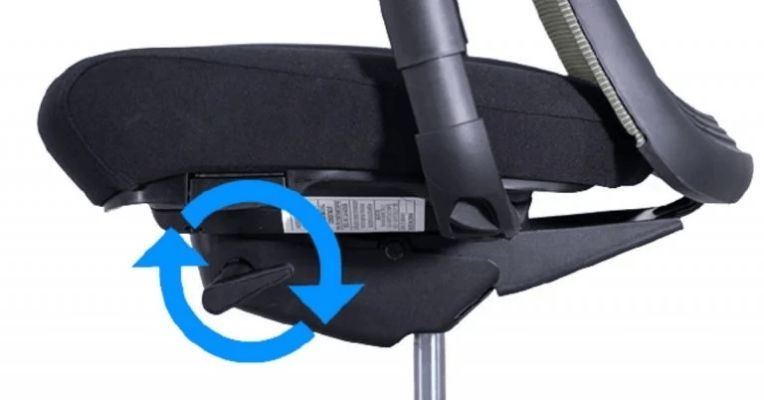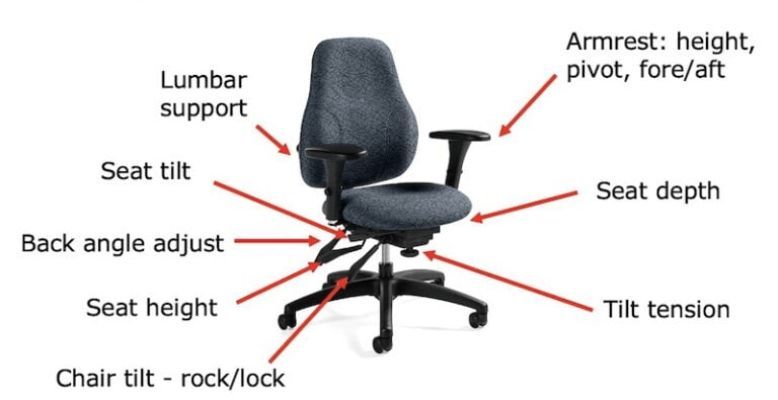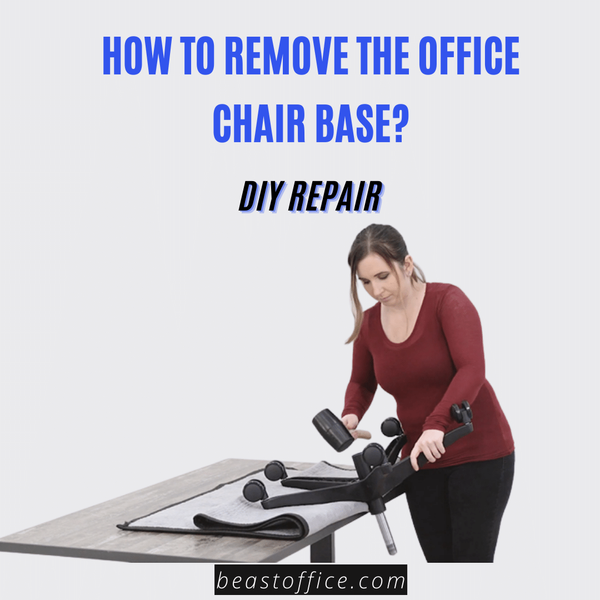If you are using a task chair or an executive chair in your office, then it is important that you adjust its seat depth properly. This will help you sit comfortably on it and avoid any discomfort or strain while working.
A good rule of thumb is to ensure that your knees are at 90 degrees when you are seated. If they do not touch the front of your desk or table, then your office chair seat is too deep for you and needs to be adjusted.
This article will show you office chair seat depth adjustment in the complete guide. And provide you the answer in detail to how to adjust office chair seat depth.
What is the best seat depth for an office chair?

Usually, 17-20 inches wide is the standard. However, the best office chair seat depth depends on your body type and posture. A shorter person will need a shorter seat depth, while a tall person will need a longer one.
A good rule of thumb is to ensure that your knees are at 90 degrees when you are seated. If they do not touch the front of your desk or table, your office chair seat is too deep for you and needs to be adjusted.
Many people have different preferences regarding the length of their office chair seats. Some like their legs fully extended, while others prefer their feet to rest flat on the floor, even when seated. Many factors contribute to this preference, including height and body type (e.g., short legs versus long legs).
In addition, some people enjoy having their feet flat on the floor as it provides them with more stability than if they were resting their feet on top of an adjustable pedal base. Whatever your preference may be, you must find an office chair that fits your budget and your specific needs to remain comfortable throughout your workday.
What To Check Before Adjusting Seat Depth?
The seat depth adjustment is one of the most critical adjustments on your office chair. It affects your posture, comfort, and overall health.
The ideal seat depth is based on your height and weight. If you're tall, a deeper seat will give you more support. If you're short, a shallower seat will provide better mobility.
If you have back problems or trouble moving around in an office chair, you should consult a professional before adjusting your seat depth. The improper adjustment can cause more pain than it relieves.
Before adjusting the seat depth on your office chair, check for these things:
Seat Pan Height
The first thing to check is how high or low the seat pan is on your chair. This will make a difference in how far you need to move the chair back to make room for your legs while at the same time keeping your shoulders well-supported.
Distance From Your Back Of The Chair
The next thing to look at is how far away from you the back of the chair is. You may need help getting comfortable with it if it's too close. The ideal distance between your knees and torso is about an inch or two less than shoulder width.
If you can't find a good position with this distance, consider adjusting it so that it's just slightly closer than shoulder width, allowing for better support of your upper body without restricting movement too much.
Armrest Height And Angle
Adjust or replace any armrests on your office chair, so they're adequately positioned for you. Some people prefer having their elbows on armrests, while others prefer having them raised off their arms altogether.
Adjusting them will allow for more comfort and support during long working periods at a desk by giving your upper body a break from the keyboard and mouse.
Seatback Angle
If sitting in an office chair with built-in lumbar support, ensure it's adjusted correctly. Many chairs have adjustable lumbar support mechanisms that are easy to use and have little knobs that can be turned with your fingers.
If you don't have one, look into getting a lumbar cushion that fits under your clothing and provides additional support where it's needed most.
Check The Lever Under The Office Chair

The lever to adjust the depth of a seat is located under the chair. To get access, you will need to flip up the seat cushion—this may be done either manually or automated by pressing the button on the side of the chair.
Adjust Through Metal Arms Of Your Office Chair

The mechanism comprises one or more metal arms and pulleys connected and mounted underneath your desk chair. A handle attached to this assembly allows you to pull it back and forth, which adjusts how far away from your body your seat will be when you sit in it.
NOTE: It's important for good posture and to prevent discomfort or injury over time (especially if you spend long hours sitting at work).
How to Adjust Office Chair Seat Depth? - Let's Find Out

There are a few different ways to adjust the seat depth.
Control Lever
One method is using a control lever below the seat and reaching under your chair to pull it up or down. This lever will usually be on either side or the back of your office chair.
Adjustment Knob

Another way is through an adjustment knob on top of your chair, allowing you to slide it back and forth without reaching under it easily. You may find that some chairs have both types of controls for easier access, but if yours doesn't, no worries! Check where yours is located when setting up shop for work each day!
Mechanism
To adjust the depth of your seat, you will need to find the mechanism underneath it. This will be located on either side of the chair between the backrest and seat cushion.
To raise or lower your chair's seat depth, push forward or backward on this control lever until you reach your desired position. You may need to readjust this lever several times as you get used to sitting at different levels to find a comfortable seating position.
Why Is Seat Adjustment is Necessary?
The seat is adjustable to find the most comfortable position for your body size and shape. The seat height is adjustable, so you can change it to suit your preference.
Seat adjustment is also important if you have bad back or spinal problems.
If You Are Tall Or Short
If you are tall or short, you might need help getting into a good sitting posture when using a chair with an adjustable seat height. A low-back chair with an adjustable seat height allows you to sit in a reclined position and maintain good posture.
Base Of The Chair Can Adjust Well
In addition, an adjustable seat depth means that the base of the chair can be adjusted by sliding forward or backward. This allows a better fit for different users and between the chair and desk.
Office Chair Seat Depth Adjustment for Minimal Pressure at the Knees
Office workers spend a lot of time sitting in their office chairs. Researchers at a University found that the average office worker sits for 8-9 hours a day. Over time, this can result in back pain, neck pain, and even Carpal Tunnel Syndrome (Cts). CTS is caused when the median nerve is compressed or irritated as it travels through the wrist.
How To Avoid Medical Issues Occur By Wrong Seat Postures?
The major key to avoiding these problems is to adjust your office chair to fit your body size and shape so that you are not working with an uncomfortable posture while sitting at your desk.
Best Way
The best way to reach this is by using an adjustable Lumbar support pillow which provides extra support in the lower back area and better pressure relief at the knees.
This helps prevent unnecessary pressure on your lower back from prolonged sitting, which can lead to reduced blood circulation and nerve compression, which causes pain in the lower back region.
Comfort And Long-Term Health
Making changes to your chair is important for comfort and long-term health. Adjustments should be made based on your body type, so consult a medical professional if you have questions.
If you can’t sit comfortably in the chair sometimes, it may be time to consider making some adjustments. When changing the seat position, try doing so gradually over time rather than all at once.
How To Reduce Lower Back Muscle Tension?
Some ways to avoid or reduce lower back muscle tension when using an office chair.
Adjust Seat Depth
One of these is by adjusting the seat depth of your office chair. The seat depth directly refers to the distance between your thighs and knees while sitting on an office chair. A good office chair should be able to provide enough space for your body so that it can maintain good posture while sitting on it.
Keep Your Feet Flat
Another way to avoid lower back muscle tension is by keeping your feet flat on the floor when using an office chair. This means you should never cross your legs while using such furniture since this will cause unnecessary strain on your lower back muscles and other body parts such as arms and shoulders.
It may lead to serious injuries if done repeatedly over time, especially if these movements are done forcefully without proper technique, in injury.
How to Avoid or Reduce Low Back Muscle Tension?
The best way to avoid or reduce low back muscle tension is to maintain a proper sitting posture. The first step in correcting the problem is determining if you are sitting too far back in your chair or leaning forward to compensate for a short seat depth.
The best way to do this is to sit in a chair with a more extended seat depth and see if your posture improves. If it does, the problem was caused by your current chair's seat depth being too short.
If not, you're leaning forward to compensate for your contemporary chair's seat depth being too short. If you have a chair with adjustable arms, move them out as far as possible towards the front of the chair. If they are not flexible, these tips may help:
- Spread your legs out as far as possible into the floor until they feel comfortable and stable without leaning forward to maintain balance or support their weight on the balls of their feet (or heels).
The seat depth on an office chair is the distance between where your butt rests and the back of the chair. You will need to locate the adjustment lever on the front of the chair to adjust it.
It's usually located underneath where your knees rest, but in some models, it can be found at the very bottom of the seat. You can also adjust this lever with your fingers if you know how to do so.
- Place one foot flat on the floor while keeping your other foot on its toe so that it's raised off of its heel slightly (about 2 inches). Then place that foot flat on the floor just behind where it was before (on its toe again). Repeat this process until you get used to it.
FAQs
Q. What is meant by a "pneumatic lift"?
A pneumatic lift is a device used to adjust the height of an office chair. It's usually found underneath the chair's base, where you can find a lever attached to a cylinder filled with air. This cylinder is attached to another lever which helps raise or lower the chair when pulled up or pushed down.
Q. Will my chair always have a backrest?
Some chairs are designed with no backrest, while others have one that you can adjust up or down depending on your comfort level. Some chairs have a fully adjustable headrest positioned along the backrest's length.
Q. How do I know which type of seat would be best for me?
It depends on what kind of work you're doing and how long you sit at your desk each day. If you are typing for most of the day, then an ergonomic office chair with built-in lumbar support would be best for your health and posture.
If you spend more time talking on the phone or visiting co-workers, consider getting an executive chair with armrests so that you don't have to support yourself while reclining in your seat.
Q. Should I get an over-sized office chair if I'm tall and overweight?
“If you're tall and overweight, an over-sized office chair may be a good choice for helping you avoid back pain,” says Dr. Robert Chen.
Which tool is made for seat adjustment?
A seat slider is a tool used to adjust the depth of the seat. The slider has two components, the knob, and the actual slider. The knob can be turned to raise or lower the seat's height.
For example, if you are tall and need a higher chair, you would turn the knob clockwise until you reach your desired height.
To lower your seat, turn the knob counterclockwise until you get to your desired position. This tool is straightforward but effective in adjusting your chair's height.
Why do I need to adjust the depth of my office chair seat?
The depth of a chair should be adjusted so that it supports your body weight evenly across both buttocks and thighs. If this isn’t possible with standard height adjustments, then it’s time to look at adjustable seat depth options.
How do I measure office chair seat depth?
To measure seat depth, sit in your office chair with your feet flat on the floor and knees bent at 90 degrees (or close). Then place a ruler between your legs and measure up to where it touches your backside.
Which Factors Based On Office Chair Adjustment?
Adjusting the depth of a chair seat should be done based on the following factors:
- Height
- Weight
- Posture
What is the standard depth for an office chair?
The standard depth for an office chair is 18 inches (46 cm). If you are shorter than 5’6″, you may need a shorter seat depth. If you have a long torso or broad shoulders, you may need a deeper seat depth.
Is Choosing Supportive Material For Your Seat May help?
If you want more support for your lower back, choose a chair with a seat pan made of foam or gel-infused mesh fabric. Try mesh fabric or leather upholstery if you want something that breathes better but still has some cushioning.
Material is one of the most important factors when looking at office chairs. You will find that many different types of material are available, and each has its own set of pros and cons.
Cushioning Material: The cushions on your seat make the chair comfortable for you to sit on for long periods. There are a few different types of cushioning material that you can choose from:
Foam: Foam is usually used in low-end office chairs because it is cheap and easy to manufacture. It also tends to be too soft and doesn't provide much support for your back or hips.
Plastic: Plastic cushions are less standard than foam but provide more support than foam. They work well for those who want something between foam and leather.
Leather: These seats are usually found in higher-end chairs because they provide excellent lumbar support and help keep your bottom cool during hot days.
Final Words
The seat depth adjustment is one of the most important features of a chair. It allows you to customize your seating experience for comfort and health. The correct positioning of your body will help alleviate back pain, prevent injury and increase productivity at work.
If you're unsure how to adjust your chair's seat depth, consult a medical professional. If you have questions about adjusting your office chair at home, consult an expert before making any changes.








